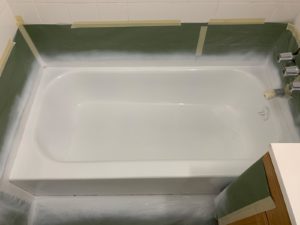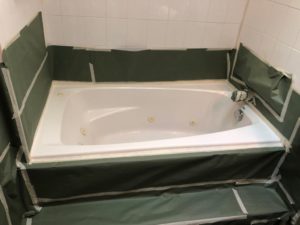Reglazing a bathtub is quickly becoming the preferred way to breathe new life into the old fixture. Did you know that during the refinishing process, our experts even repair the cracks, chips and dents on your tub? Or that we always remove all the rust before refinishing the tub? Truth be told, refinishing a tub is a cost-effective way to keep your fixture in perfect condition for a long time – and without spending a small fortune.

But how do you take care of a reglazed bath tub? How do you clean it? What solutions should you use and which ones should you avoid? In this blog post, we will discuss the proper way to take care of a resurfaced tub. We will also tell you what not to do, of course. Read on!
What Does Reglazing Mean?
To understand the cleaning advice in the next part of the blog post, we should explain the reglazing process. Many homeowners don’t know what’s involved and how the refinishing is done, so they don’t understand why some cleaning solutions are better than others at cleaning a resurfaced tub. Here is how our experts reglaze a tub:
- First, everything surrounding the fixture is covered. We don’t want the chemicals or the coating to touch other surfaces (including the wall and floor tiles).
- The entire surface of the tub is sanded down. Alternatively, we may use etching chemicals to achieve the desired result. This depends on the type of bathtub we are dealing with.
- If there are dents, cracks or chips on the surface of the tub, our expert will repair them.
- If there is rust present, we will remove it entirely before proceeding to the next step.
- A layer of primer is applied to the surface of the tub and left to cure for a bit. This layer will ensure a strong bond between the coating and the tub. In other words, the coating will not peel off in one or two years.
- A layer of coating is applied evenly over the surface of the tub. If necessary, we can apply a second layer. Once these layers cure, they resemble enamel. In other words, the bathtub will look and feel just like a brand new one.

What NOT to Do to a Refinished Bathtub
Now that you understand the bathtub resurfacing process, it’s time to tell you what you should NEVER do to a refinished fixture. Most importantly, you should never attempt to use any cleaning solutions on the tub for at least 7 days. If you need to clean the tub, use soap and a soft sponge. During the curing period, the layer of coating can get scratched and nicked quite easily.
After the curing period if over (depending on the solutions used), you should never use any kind of abrasives. This includes cleaners that contain ammonia or bleach. Also, keep away from powdered cleansers like Comet. Use soft sponges that are not abrasive.
Also, you should never steam clean your refinished bathtub or power wash it. Steam cleaning and power washing may void the warranty of the reglazing job.
Properly Taking Care of the Tub
To properly take care of the refinished bathtub, you should use cleaning solutions such as Lysol Basin Tub or Tile Cleaner, Scrubbing Bubbles, or Formula 409. While there are many other cleaning solutions that can do the trick, most reglazing companies recommend these three.
If you don’t have any of the cleaning solutions listed above, you can safely use liquid dish soap and a sponge to get the job done. To be more effective at cleaning the tub, you should apply the cleaner on the entire surface of the tub and let it sit for around 5 minutes. Scrub the surface with a cellulose sponge or a microfiber cloth and then rinse.

If you need more information or advice on how to take care of a newly-reglazed bathtub, don’t hesitate to get in touch with us. The advice above also applies to other refinished fixtures, such as shower stalls, Jacuzzis, sinks, toilets, and urinals. When you need to reglaze bathtub NYC, we are your best option.


